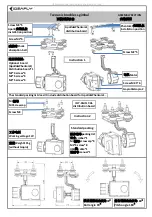
page 15
TIP:
Prop the heel of the neck with anything handy
(28)
to force a slight upbow into the neck (here we
have .012" of upbow). The upbow matches the .012"
of backbow which the fret compression created in
the fingerboard, and the two bows cancel each
other out, producing a perfectly straight neck when
dry. Later, the string tension will pull the neck into
some amount of upbow and the truss rod can be
engaged to straighten the neck. It’s good to have
some tension on the truss rod like this in order to be
able to loosen the rod slightly to introduce “relief,”
(controlled upbow in the fretboard). Relief is need-
ed for players with a heavy attack that causes
buzzing. The relief offers clearance for the elliptical
motion of plucked strings as they vibrate. Not all
players want or need relief, though.
When the fingerboard’s dry, remove the rubber band clamp.
The bone nut blank should be smooth-walled, square-bot-
tomed, and of uniform thickness. If it needs smoothing or
thicknessing, sand it with 100- and 220-grit sandpaper, dou-
ble-stick taped to a flat surface.
Place the nut blank on the flat ledge between the end of the
fingerboard and the break angle of the peghead. File or sand
a 14° angle on one end of the peghead overlay so that it
butts flush to the back edge of the nut
(29)
. When the over-
lay is glued on, the space between the overlay and the
fingerboard will be a perfectly-sized channel for the nut.
Dry-clamp the overlay in place. With a pencil, mark a point 1-
9/16" from the back edge of the nut, centered on the
Installing the peghead overlay
27.
Get plenty of wraps on the heel.
28.
Prop the heel of the neck to force a slight upbow
into the neck.
Place the fingerboard onto the evenly-glued neck surface
and center the 14th fret slot directly over the edge of the
neck heel. Hold the fingerboard in place temporarily with a
spring clamp
(26)
as you start to wrap with the rubber bands
supplied with your kit. Tie the rubber band at the peghead
and wrap from end-to-end and back again. Get plenty of
wraps on the heel
(27)
. You may find that one rubber band
is all that’s needed for the job. You can shift the fingerboard
slightly from side-to-side as you wrap, but usually the board
will center itself nicely.
29.
File or sand a 14° angle on one end of the overlay so that it fits
flush to the nut.












































